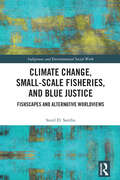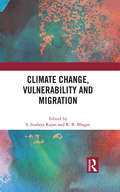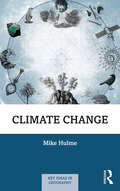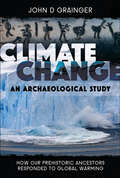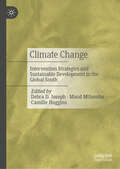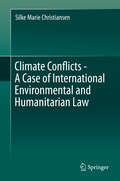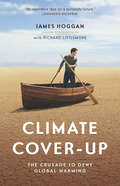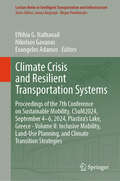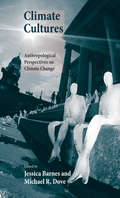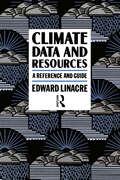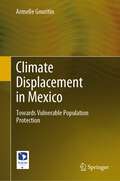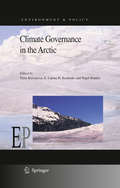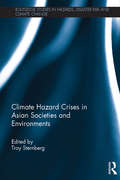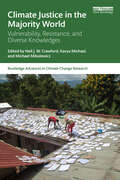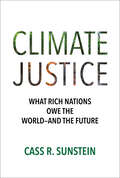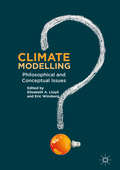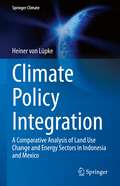- Table View
- List View
Climate Change, Shifting Cultivation and Livelihood Vulnerabilities in India: An Analytical Study
by Sunil Nautiyal Niranjan Roy Avijit DebnathThis book explores how climate change affects households that rely on shifting cultivation and how to assess their vulnerability. This study looks at micro and macro levels in Indian states with indigenous communities practicing shifting cultivation. The micro-level study has been conducted in 52 villages, with 1469 households covering 7067 population in seven states of India in the Northeastern region. The book covers different topics related to climate change, such as its patterns, impact on households and agriculture, forest management, and the role of indigenous knowledge in mitigation. This research is associated with different sectors like shifting agriculture, forestry sector, climate change and rural development etc. and integrated with large respondents and stakeholders through both direct and focus group discussions. Research scholars, climate activists, institutional and non-institutional organisations, people interested in environmental science, social science and policymakers will find this book very relevant.
Climate Change, Small-Scale Fisheries, and Blue Justice: Fishscapes and Alternative Worldviews (Indigenous and Environmental Social Work)
by Sunil D. SanthaThis book is a narrative non-fiction, based on the patchy epistemologies of traditional small-scale fishers in India and the Indian Ocean region. It specifically explores the impact of climate change on Fish and Fishers, and the mutual entanglements in their eco-social world. Further, it critically examines the nature of climate change adaptation and its implications on small-scale fisheries. Both climate change impact and adaptation responses are examined from the situated knowledge and everyday lived experiences of Fishers. Stories of their everyday struggles from diverse eco-social worlds shape these patchy epistemologies. Further, this book through these stories unearths the transitions in governance and changing relationships between Fish, Fishers, and the rest of the eco-social world. Responding ethically to the problems of climate change, warming oceans, fish scarcity, overfishing, and pollution requires us to break away from the paradigms that locate Nature and Society as binaries and commodities. Blue justice can be achieved only if strategies aimed at adaptation, conservation and well-being are dialogical, inclusive, and Fish-Fisher centred. This book offers insights into the worldviews of Fishers and their stewardship, wisdom, and experience in healing today’s warming world. Locating the eco-social worlds of Fish and Fishers in alternative worldviews, this book strives to find meaningful pathways for just transitions. It will be of interest to academics and researchers working in the field of climate change, fisheries, disaster studies, and sustainable livelihoods as well as related subjects of social work and social justice.
Climate Change, Vulnerability and Migration
by S. Irudaya Rajan R. B. BhagatThis book highlights how climate change has affected migration in the Indian subcontinent. Drawing on field research, it argues that extreme weather events such as floods, droughts, cyclones, cloudbursts as well as sea-level rise, desertification and declining crop productivity have shown higher frequency in recent times and have depleted bio-physical diversity and the capacity of the ecosystem to provide food and livelihood security. The volume shows how the socio-economically poor are worst affected in these circumstances and resort to migration to survive. The essays in the volume study the role of remittances sent by migrants to their families in environmentally fragile zones in providing an important cushion and adaptation capabilities to cope with extreme weather events. The book looks at the socio-economic and political drivers of migration, different forms of mobility, mortality and morbidity levels in the affected population, and discusses mitigation and adaption strategies. The volume will be of great interest to scholars and researchers of environment and ecology, migration and diaspora studies, development studies, sociology and social anthropology, governance and public policy, and politics.
Climate Change: A Case Against Climate Engineering (Key Ideas in Geography)
by Mike HulmeWritten by a leading geographer of climate, this book offers a unique guide to students and general readers alike for making sense of this profound, far-reaching, and contested idea. It presents climate change as an idea with a past, a present, and a future. In ten carefully crafted chapters, Climate Change offers a synoptic and inter-disciplinary understanding of the idea of climate change from its varied historical and cultural origins; to its construction more recently through scientific endeavour; to the multiple ways in which political, social, and cultural movements in today’s world seek to make sense of and act upon it; to the possible futures of climate, however it may be governed and imagined. The central claim of the book is that the full breadth and power of the idea of climate change can only be grasped from a vantage point that embraces the social sciences, humanities, and natural sciences. This vantage point is what the book offers, written from the perspective of a geographer whose career work on climate change has drawn across the full range of academic disciplines. The book highlights the work of leading geographers in relation to climate change; examples, illustrations, and case study boxes are drawn from different cultures around the world, and questions are posed for use in class discussions. The book is written as a student text, suitable for disciplinary and inter-disciplinary undergraduate and graduate courses that embrace climate change from within social science and humanities disciplines. Science students studying climate change on inter-disciplinary programmes will also benefit from reading it, as too will the general reader looking for a fresh and distinctive account of climate change.
Climate Change: Conflict and Resilience in the Age of Anthropocene (Advances in Global Change Research #80)
by Uday Chatterjee Subodh Chandra Pal Asish Saha Dipankar RuidasThis book illustrates a geospatial technology approach to data mining techniques, data analysis, modelling, risk assessment and visualization and management strategies in many elements of natural and societal hazards. This book delves into cutting-edge techniques based on open-source software and R statistical programming, Google Earth Engine and modelling in modern artificial intelligence techniques, with a particular emphasis on recent trends in data mining techniques and robust modelling in water resource crisis-related hazards. Furthermore, this book also discusses how to manage water resources at various local, regional and international levels while incorporating environmental considerations. This book contains works that address the connection between climate change, extreme events and resilience. These works include those that identify and evaluate policies, quantify the effects of public interventions, climate change on extreme events, describe the decision-making process and its role in modelling for resilience. This book's subjects be of interest to earth and environmental scientists, professionals and authorities. This book focuses at geospatial modelling and climate change management. A relationship between three technologies, including remote sensing (RS), geographic information systems (GIS) and the R programming environment, is acknowledged as particularly effective in this regard. This book, on the other hand, serves as a practical guide to identify the most recent breakthroughs in geospatial and geostatistical approaches and their application in the field of subsurface water-induced hazards throughout the world. This book is specifically designed to serve the community of Undergraduates, Postgraduates and Researchers, Policymakers, Environmentalists, Natural Hazards and Disasters Management, NGOs, Corporate Sectors, Social Scientists, and Government Organizations in the fields of Environmental Sciences, Geography, Hydrology, Natural Hazards, Geospatial Sciences, Remote Sensing & GIS, Agriculture, Crop-Science, Forestry, Soil Science, Agronomy, Humanistic & Social Sciences and so on.
Climate Change: How Our Prehistoric Ancestors Responded to Global Warming
by John D. GraingerHow prehistoric humans coped with the end of the last Ice Age—and catastrophic global warming.Global warming is among the most urgent problems facing the world today. Yet many commentators, and even some scientists, discuss it with reference only to the changing climate of the last century or so. John Grainger takes a longer view and draws on the archaeological evidence to show how our ancestors faced up to the ending of the last Ice Age, arguably a more dramatic climate change crisis than the present one. Ranging from the Paleolithic down to the development of agriculture in the Neolithic, the author shows how human ingenuity and resourcefulness allowed them to adapt to the changing conditions in a variety of ways as the ice sheets retreated and water levels rose. Different strategies, from big game hunting on the ice, nomadic hunter gathering, sedentary foraging, and finally farming, were developed in various regions in response to local conditions as early man colonized the changing world. The human response to climate change was not to try to stop it, but to embrace technology and innovation to cope with it.
Climate Change: How Our Prehistoric Ancestors Responded to Global Warming
by John D. GraingerHow prehistoric humans coped with the end of the last Ice Age—and catastrophic global warming.Global warming is among the most urgent problems facing the world today. Yet many commentators, and even some scientists, discuss it with reference only to the changing climate of the last century or so. John Grainger takes a longer view and draws on the archaeological evidence to show how our ancestors faced up to the ending of the last Ice Age, arguably a more dramatic climate change crisis than the present one. Ranging from the Paleolithic down to the development of agriculture in the Neolithic, the author shows how human ingenuity and resourcefulness allowed them to adapt to the changing conditions in a variety of ways as the ice sheets retreated and water levels rose. Different strategies, from big game hunting on the ice, nomadic hunter gathering, sedentary foraging, and finally farming, were developed in various regions in response to local conditions as early man colonized the changing world. The human response to climate change was not to try to stop it, but to embrace technology and innovation to cope with it.
Climate Change: Intervention Strategies and Sustainable Development in the Global South
by Camille Huggins Debra D. Joseph Maud MthembuThis book highlights the challenges with respect to climate change in the Global South. It demonstrates what has been happening in varying countries in this geographic location and how sustainable adaptation interventions could be used to alleviate these challenges. Most countries in the Global South are extremely vulnerable and unprepared for the present and future impact of climate change. Some climate change events that are presently plaguing these locations are extreme weather events such as flooding, food insecurity, disasters and droughts. The book provides case studies and interventions that can be a source to others who are seeking to find solutions to these adverse climate change events.
Climate Conflicts - A Case of International Environmental and Humanitarian Law
by Silke Marie ChristiansenThe bookaddresses the question of whether the currently available instruments ofinternational environmental and international humanitarian law are applicableto climate conflicts. It clarifies the different pathways leading from climatechange to conflict and offers an analysis of international environmental lawembedded within the international doctrine of state responsibility. It goes onto discuss whether climate change amounts to an issue covered by Art. 2. 4 UNCharter - the prohibition of the use of force. It then considers the possibleapplication of international humanitarian law to climate conflicts. The bookalso offers a definition of the term "climate conflict", drawing on legal aswell as peace and conflict studies.
Climate Cover-Up: The Crusade to Deny Global Warming
by Richard Littlemore James HogganThis &“must-read book describes in disturbing detail&” how the energy industry has fueled a bogus controversy about manmade climate change (Toronto Star). This book rips the lid off the campaign to discredit scientists, confuse journalists, and deny climate change. The tactics have been slick, but PR expert James Hoggan and investigative journalist Richard Littlemore have compiled a readable, accessible guidebook through the muck. Beginning with leaked memos from the coal industry, the oil industry and the tobacco-sponsored lie-about-science industry, the authors expose the plans to "debunk" global warming; they track the execution of those plans; and they illuminate the results—confusion, inaction, and an epidemic of public mistrust. Climate Cover-Up names names, identifying bogus experts who are actually paid lobbyists and flaks. The authors reveal the PR techniques used to misinform, to mangle the language, and to intimidate the media into maintaining a phony climate change debate. Exposing the seedy origins of that debate, this book will leave you fuming at the extent, the effect, and the ethical affront of the climate cover-up.
Climate Crisis and Resilient Transportation Systems: Proceedings of the 7th Conference on Sustainable Mobility, CSuM2024, September 4–6, 2024, Plastira’s Lake, Greece - Volume II: Inclusive Mobility, Land-Use Planning, and Climate Transition Strategies (Lecture Notes in Intelligent Transportation and Infrastructure)
by Eftihia G. Nathanail Nikolaos Gavanas Evangelos AdamosThis book reports on original research and practical findings fostering collaborative, inclusive, just, safe and climate neutral transportation planning. Being the second volume of the proceedings of the 7th Conference on Sustainable Mobility (CSuM 2024), held on September 4–6, 2024, at Plastira’s Lake, Greece, it describes state-of-the-art models, techniques, and applications that enable the transition of transportation systems to support sustainable societies. All in all, this book offers extensive information to academicians, researchers, practitioners and decision makers working on effective strategies to transform mobility in a sustainable and equitable way.
Climate Cultures
by Michael R. Dove Ms Jessica BarnesClimate change is one of the most pressing issues of our times, yet also seemingly intractable. This book offers novel insights on this contemporary challenge, drawing together the state-of-the-art thinking in anthropology. Approaching climate change as a nexus of nature, culture, science, politics, and belief, the book reveals nuanced ways of understanding the relationships between society and climate, science and the state, certainty and uncertainty, global and local that are manifested in climate change debates. The contributors address three major areas of inquiry: how climate change issues have been framed in previous times compared to the present; how knowledge about climate change and its impacts is produced and interpreted by different groups; and how imagination plays a role in shaping conceptions of climate change.
Climate Data and Resources: A Reference and Guide
by Edward LinacreClimate may be defined as the synthesis of long-term atmospheric conditions characteristic of a particular place. Consequently, the study of climate relies on sustained records of daily values. However, both location and equipment are variables and precise measurements may not be possible. There are occasions when an estimate rather than a measurement is necessary, as when gauging the unrecorded past or future. The value of applied climatology - the study of the impact of climate - lies in the analysis of measurements and estimates within the context of change. Climate Data and Resources provides a review of the theory and practice underlying current climactic research. The author describes the nature of atmospheric resources - solar radiation, wind and precipitation - and describes the specification, obtaining and treatment of climate data. Fully referenced and illustrated, Climate Data and Resources should prove a valuable resource to all those interested in the collection and analysis of climatic data.
Climate Displacement in Mexico: Towards Vulnerable Population Protection
by Armelle GouritinThis book presents the updated results of an investigation carried out in 2019. The National Autonomous University of Mexico’s (UNAM) Climate Change Research Program (PINCC), funded the research coordinated by Armelle Gouritin. The research aims to answer the following questions: Does the Mexican legal framework and public policies address forced internal climate mobility? If not, what could be the elements of a legal framework and public policies to address the phenomenon? As the phenomenon was approached it was clear that it was extremely complex and consisted of numerous tensions that would lead to other questions throughout the research process.Climate forced internal displacement is projected as a huge-scale phenomenon in Mexico. Against this background, the book provides the first critical diagnosis of the current politico-legal Mexican framework and finds it to be lagging behind in terms of prevention and attention. The book analyses the three-level Mexican governance (federal, state and local levels), and identifies serious loopholes according to a rights-based approach that particularly focuses on women, indigenous peoples, and persons and communities with scarce economic resources. The results provide information on up-coming legislative and political processes and provide benchmarks that can be applied in other case-studies, including other national frameworks’ critical analysis.
Climate Finance as an Instrument to Promote the Green Growth in Developing Countries (SpringerBriefs in Climate Studies)
by Antonio A. Romano Giuseppe Scandurra Alfonso Carfora Monica RonghiThis book analyses the effectiveness of climate finance as political instrument to reduce the effect of anthropogenic activities on climate change and promote the green growth in developing countries. The book highlights that close attention should also be paid to the analysis of political contexts in a broad sense. Particularly focusing on the international negotiations process that enables the direction of funds toward specific needs and priorities and the issue of access to electricity. For example, the difficulties that developing countries face when trying to improve their green economic development without access to carbon remains a matter of the utmost importance and urgency for many developing countries that lack significant aid from developed countries. This book will be of interest to a wide body of academics and practitioners in climate change and energy policies. Moreover, this project is a valid instrument for students in energy policies and climate programs.
Climate Governance in the Arctic (Environment & Policy #50)
by E. Carina Keskitalo Nigel Bankes Timo KoivurovaClimate change is affecting the Arctic environment and ecosystems at an accelerating speed, twice the rate of the global average. This is opening the Arctic to transportation and resource development and creating serious challenges for local communities and indigenous peoples. Climate Governance in the Arctic considers two aspects of climate change from an institutional perspective. It focuses on how relevant regimes, institutions and governance systems support mitigation of climate change. It also examines the extent to which the varying governance arrangements in the Arctic support adaptation and the development of adaptation processes for the region. The book's focus on Arctic governance offers unique insights within climate change mitigation and adaptation research.
Climate Hazard Crises in Asian Societies and Environments (Routledge Studies in Hazards, Disaster Risk and Climate Change)
by Troy SternbergClimate hazards are the world’s most widespread, deadliest and costliest natural disasters. Knowledge of climate hazard dynamics is critical since the impacts of climate change, population growth, development projects and migration affect both the impact and severity of disasters. Current global events highlight how hazards can lead to significant financial losses, increased mortality rates and political instability. This book examines climate hazard crises in contemporary Asia, identifying how hazards from the Middle East through South and Central Asia and China have the power to reshape our globalised world. In an era of changing climates, knowledge of hazard dynamics is essential to mitigating disasters and strengthening livelihoods and societies across Asia. By integrating human exposure to climate factors and disaster episodes, the book explores the environmental forces that drive disasters and their social implications. Focusing on a range of Asian countries, landscapes and themes, the chapters address several scales (province, national, regional), different hazards (drought, flood, temperature, storms, dust), environments (desert, temperate, mountain, coastal) and issues (vulnerability, development, management, politics) to present a diverse, comprehensive evaluation of climate hazards in Asia. This book offers an understanding of the challenges climate hazards present, their critical nature and the effort needed to mitigate climate hazards in 21st-century Asia. Climate Hazard Crises in Asian Societies and Environments is vital reading for those interested and engaged in Asia’s development and well-being today and will be of interest to those working in Geography, Development Studies, Environmental Sciences, Sociology and Political Science.
Climate Justice and Disaster Law
by Rosemary LysterClimate disasters demand an integration of multilateral negotiations on climate change, disaster risk reduction, sustainable development, human rights and human security. Via detailed examination of recent law and policy initiatives from around the world, and making use of a capability approach, Rosemary Lyster develops a unique approach to human and non-human climate justice and its application to all stages of a disaster: prevention; response, recovery and rebuilding; and compensation and risk transfer. She comprehensively analyses the complexities of climate science and their interfaces with the law- and policy-making processes, and also provides an in-depth analysis of multilateral climate change negotiations under the 1992 United Nations Framework Convention on Climate Change.
Climate Justice in the Majority World: Vulnerability, Resistance, and Diverse Knowledges (Routledge Advances in Climate Change Research)
by Michael Mikulewicz Kavya Michael Crawford, Neil J. WThis edited collection explores a diverse range of climate (in)justice case studies from the Majority World – where most of humans and non-humans live. It is also the site of the most severe impacts of climate change and home to some of the key solutions for the climate crisis. The collection brings together 12 chapters featuring the work of over 30 authors from around the globe. The impacts of climate change are disproportionately affecting individuals, communities, and countries in the Majority World who historically have contributed little to rising global temperatures. The 12 chapters focus on a range of cross-cutting themes, demonstrating both individual and collective experiences of climate change and struggles for achieving climate justice from the Majority World. This includes activism, resistance, and social movement organizing in India and Brazil; lived experiences and understandings of frontline communities in Bangladesh and South Africa; consequences of and responses to disasters in Mozambique and Puerto Rico; and contested accounts, narratives, and futures in the Maldives and Pakistan, among other topics. By adopting a decolonial lens, this book provides rich empirical content, insightful comparisons, and novel conceptual interventions. It foregrounds climate justice from an intersectional perspective and contributes to the ongoing efforts by scholars and activists to address epistemic injustice in climate change research, policy, and practice. It will appeal to undergraduate and graduate-level students, academics, activists, policymakers, and members of the public concerned with the impacts and inequalities of climate change in the Majority World.
Climate Justice: What Rich Nations Owe the World—and the Future
by Cass R. SunsteinThe social cost of carbon: The most important number you've never heard of—and what it means.If you're injuring someone, you should stop—and pay for the damage you've caused. Why, this book asks, does this simple proposition, generally accepted, not apply to climate change? In Climate Justice, a bracing challenge to status-quo thinking on the ethics of climate change, renowned author and legal scholar Cass Sunstein clearly frames what’s at stake and lays out the moral imperative: When it comes to climate change, everyone must be counted equally, regardless of when they live or where they live—which means that wealthy nations, which have disproportionately benefited from greenhouse gas emissions, are obliged to help future generations and people in poor nations that are particularly vulnerable. Invoking principles of corrective justice and distributive justice, Sunstein argues that rich countries should pay for the harms that they have caused and that all of us are obliged to take steps to protect future generations from serious climate-related damage. He shows how “choice engines,” informed by artificial intelligence, can enable people to save money and to reduce the harms they produce. The book casts new light on the “social cost of carbon,” the most important number in climate change debates—and explains how intergenerational neutrality and international neutrality can help all nations, above all the United States and China, do what must be done.
Climate Lyricism
by Min Hyoung SongIn Climate Lyricism Min Hyoung Song articulates a climate change-centered reading practice that foregrounds how climate is present in most literature. Song shows how literature, poetry, and essays by Tommy Pico, Solmaz Sharif, Frank O’Hara, Ilya Kaminsky, Claudia Rankine, Kazuo Ishiguro, Teju Cole, Richard Powers, and others help us to better grapple with our everyday encounters with climate change and its disastrous effects, which are inextricably linked to the legacies of racism, colonialism, and extraction. These works employ what Song calls climate lyricism—a mode of address in which a first-person “I” speaks to a “you” about how climate change thoroughly shapes daily life. The relationship between “I” and “you” in this lyricism, Song contends, affects the ways readers comprehend the world, fostering a model of shared agency from which it can become possible to collectively and urgently respond to the catastrophe of our rapidly changing climate. In this way, climate lyricism helps to ameliorate the sense of being overwhelmed and feeling unable to do anything to combat climate change.
Climate Management Issues: Economics, Sociology, and Politics
by Julie K. GinesDespite all the controversy and hype that climate change has generated, there now exists an overwhelming body of scientific evidence that the problem is real and that its effects are already being felt on a global scale. Part of what makes this a volatile and controversial issue is that it is not just confined to the realms of the scientific commun
Climate Modelling
by Elisabeth A. Lloyd Eric WinsbergThis edited collection of works by leading climate scientists and philosophers introduces readers to issues in the foundations, evaluation, confirmation, and application of climate models. It engages with important topics directly affecting public policy, including the role of doubt, the use of satellite data, and the robustness of models. Climate Modelling provides an early and significant contribution to the burgeoning Philosophy of Climate Science field that will help to shape our understanding of these topics in both philosophy and the wider scientific context. It offers insight into the reasons we should believe what climate models say about the world but addresses the issues that inform how reliable and well-confirmed these models are. This book will be of interest to students of climate science, philosophy of science, and of particular relevance to policy makers who depend on the models that forecast future states of the climate and ocean in order to make public policy decisions.
Climate Policy Integration: A Comparative Analysis of Land Use Change and Energy Sectors in Indonesia and Mexico (Springer Climate)
by Heiner von LüpkeThis book analyzes climate policy integration processes by investigating cause-effect relations in cases of integrating climate policy in energy and land-use sectors of Indonesia and Mexico, taking a novel comparative case study approach. The book identifies root causes for integration outside of the public administration, discussing decisive factors in the political economy of the energy and land-use sectors. Showing how policy windows may open for the successful integration of climate policies nevertheless, the book addresses the need to identify and properly use these windows to establish the administrative and institutional arrangements for effective climate policy implementation. This book offers two-fold insights for overcoming the challenges posed by climate policy integration: Firstly, it contributes to theory-building by amending theories of the policy process and by taking a wider perspective on the role of integration in the context of transformational change processes in emerging economies. Secondly, it sets forth a set of research-based practical policy recommendations on how to foster climate policy integration in the political decision-making processes as well as the public administration structures. Therefore, this book will appeal to scholars and researchers of public policy, public administration, political science, and environmental sciences, as well as policy-makers and practitioners interested in a better understanding of climate policy integration in energy and land-use sectors.
Climate Realism: The Aesthetics of Weather and Atmosphere in the Anthropocene (Routledge Research in the Anthropocene)
by Edited by Lynn Badia, Marija Cetinic,́ and Jeff DiamantiThis book sets forth a new research agenda for climate theory and aesthetics for the age of the Anthropocene. It explores the challenge of representing and conceptualizing climate in the era of climate change. In the Anthropocene when geologic conditions and processes are primarily shaped by human activity, climate indicates not only atmospheric forces but the gamut of human activity that shape these forces. It includes the fuels we use, the lifestyles we cultivate, the industrial infrastructures and supply chains we build, and together these point to the possible futures we may encounter. This book demonstrates how every weather event constitutes the climatic forces that are as much social, cultural, and economic as they are environmental, natural, and physical. By foregrounding this fundamental insight, it intervenes in the well-established political and scientific discourses of climate change by identifying and exploring emergent aesthetic practices and the conceptual project of mediating the various forces embedded in climate. This book is the first to sustain a theoretical and analytical engagement with the category of realism in the context of anthropogenic climate change, to capture climate’s capacity to express embedded histories, and to map the formal strategies of representation that have turned climate into cultural content.

